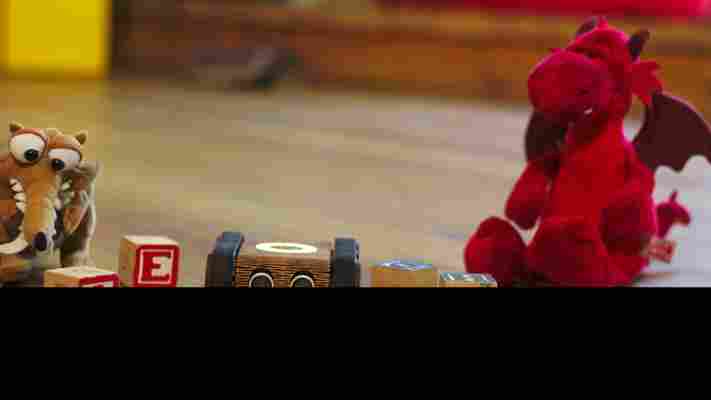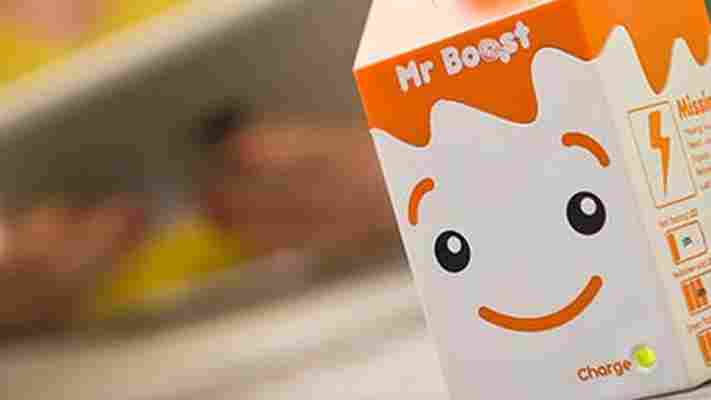At today’s Apple event in Cupertino, the tech giant unveiled an upgraded Mac mini .

The new and improved tiny computer sports 4th-gen Intel core processors and Intel Iris and HD Graphics 5000 for pushing all those pixels. It touts PCIe-based flash storage available in 500GB, 1TB and 1TB Fusion configurations. It also has two Thunderbolt 2 ports which feature dual channel 20-Gbps data transfers and connect to your Wi-Fi via 802.11ac.
The processors in the computer feature Turbo Boost 2.0, which increase the clock speed up to 2.7 GHz on the entry level 1.4 GHz model. The high-end Fusion drive has a built in PCIe flash storage that holds your frequently used apps, documents and other info so they load quicker when needed.
It also has four USB 3 ports, HDMI, SDXC, audio in, a headphone port and gigabit ethernet. It also has an IR receiver and comes with an Apple TV remote if you want to build a media center around the computer.
The Mac mini was introduced in 2005 as a bring-your-own-keyboard-and-monitor device. The idea was to introduce a low cost computer that could use the hardware you already owned. If that hardware happened to be from a Windows machine, well that was all the better to Apple.
The Mac mini starts at $499 for a 1.4 GHz dual-core Intel Core i5 and 500GB of storage, $699 for 2.6 GHz dual-core Intel Core i5 processor and 1TB of storage and $999 for 2.8 GHz dual-core Intel Core i5 processor and a 1TB Fusion drive.
The Mac mini is shipping today.
Keep up with the rest of Apple’s announcements from its iPad event here .
How Codie’s robotic toy teaches kids the principles of coding
Hungarian startup Codie has launched an Indiegogo crowdfunding campaign for its robotic toy, which teaches kids the principles of coding. With more than one third of its funding goal committed in only two days, chances are it will reach its $70,000 target earlier than expected.

The star of Codie’s campaign is its cute wood-covered robot, which kids can guide through a companion coding app. The iOS version is already in beta, with Android to follow soon. The robot also doubles as a regular toy, and can even be used as an alarm clock thanks to its brightness sensors.
While ‘early bird’ perks are already sold out , backers can still pre-order one of the toys for $169 plus shipping fees. In addition, the campaign also features rewards targeted at specific segments, such as donors, hackers and schools.
As you may remember, Codie had been one of our favorite startups a few weeks ago at Mobile World Congress in Barcelona. What first caught our attention during the event was one of the first assembled units of its robot, which is set to ship in November 2015. 25 backers will even get their unit as early as in June in exchange for a slightly higher pledge of $249.
The reason why Codie can ship relatively fast is that its team already did a lot of background work, including several prototyping and testing cycles since its inception in 2013.
As a matter of fact, Codie’s co-founders Adam Lipecz and Andras Hollo met at Startup Weekend Budapest , and won the 2013 edition of the competition with their project Robophone, renamed as Codie in October 2014 to reflect its growing ambitions.
Codie now has a team of seven members with complementary backgrounds, from engineering and design to marketing and app development. According to Peter Erdei, who is in charge of visual and UX design, Lipecz’s inspiration came from his own experience:
“Adam was teaching programming to university freshmen at the university. When he got the curriculum from his professors, he immediately realized that learning how to code is just not engaging if it is being taught that way. He has got a great passion for robotics since his childhood, he enjoyed that his programs are interacting with the real world.”
With that in mind, Lipecz and his team started to work on Codie as a way to lower the barrier of entry into programming and robotics. “With Codie, kids jump into an authentic experience that’s educational and engaging, Lipecz said. Here’s how it looks:
https://www.youtubeom/watch?v=Jj5GKCavdeM
Interestingly, Codie decided to develop its own programming language, which is touch-based and doesn’t require a keyboard. While it is inspired by other kid-oriented languages, such as Blockly and Scratch , it also brings some improvements, Erdei said:
“Commands organized into blocks is an example for that; Blockly uses action blocks as well, but we felt that their interface is complicated, we wanted to soften down the sharp edges of that language and make more fluid to use.”
In practice, Codie progressively teaches several concepts, from task execution sequences to variables, programming loops and conditionals. All of this is done through the app, which is connected to the robot via Bluetooth. Thanks to the toy’s accelerometer, gyroscope and sensors, the kids can get instantaneous feedback by watching its moves.
Codie didn’t create its programming language in isolation; it also made sure that schoolchildren would test it and share useful feedback during the development process. Its core target are 8-to-12-year-olds, although it is meant to be fun even for younger kids (and for their parents).
By making coding both tangible and entertaining, Codie hopes to encourage more kids of all ages to learn how to program — including girls. The team took this consideration into account during the development itself, Erdei explained:
“We definitely want to see more girls getting into coding in the future. We designed the robot to be appealing for girls as well by avoiding the use of features which are said to be more ‘boyish’, like wheels and sharp edges and using a more friendly-looking material: wood. We’re encouraging kids to play with Codie in every setting as it integrates well into any game, thus making coding an ordinary part of the everyday playing.”
One of Codie’s partners is Hungarian NGO Skool , whose aim is to encourage girls to code. This led Codie to help a group of Hungarian girls prepare for the local FIRST Lego League ‘s programming cup , where they won of the competition’s awards .
Codie is based in Budapest, where it is an noteworthy member of the city’s tech scene. In 2014, it won the national edition of Microsoft’s Imagine Cup, and its co-founders also took part in Startup Sauna ‘s acceleration program.
In addition, the team has raised $10,000 from an angel investor and $125,000 in seed funding from Hungarian accelerator and business development company iCatapult .
According to Lipecz, “Budapest is a really exciting city in many terms, and the startup ecosystem is developing as well. There are a few already hugely successful startups based here ( Prezi , LogMeIn , Ustream ) and there are many innovative projects going on; a few recent notable examples are Brewie , Synetiq or Tago Arc , and there are a constant stream of fresh projects, too.”
The city’s low cost of living means that startups can maintain a low burn rate, which helps attract and retain early-stage companies. “Many creative minds are here in the city and we’d be really happy if Codie could contribute to making Budapest a big startup hub of Europe,” he concluded.
15 quirky gadgets and accessories to buy today
It’s time for us to take another look at a bunch of quirky, imaginative and downright useful gadgets and accessories that you can buy today. Which one takes your fancy the most?

For more inspiration, check out our 2013 holiday gift guide , our previous collection of gadgets and accessories for geeks and 15 quirky gadgets and accessories to buy today , and even more here.
You can view all 15 of these gadgets and accessories listed on one page here .
A handy way of adding things to your shopping list, the Hiku Grocery Shopping Aid scans the barcodes of items around your house or in stores and adds them to an accompanying iPhone app. Even if it only saves you a few seconds with every item, those seconds add up and let’s face it, scanning barcodes is more fun than tapping away at an on-screen keyboard. $79
Click the image for more information
Forget your standard inflexible power strip, the Pivot Power Pop lets you arrange its six US-style two-pin sockets in a shape that best suits you and the space you have available. $20
Click the image for more information
This Bluetooth LE device is designed to be a better flash for your smartphone offering more natural tones and less of the washed-out look that can often blight shots taken with a built-in flash. Note that although Android is supported, the iOS user experience via its accompanying app is currently much better so we’d recommend this for iPhone users only for the time being. $60
Click the image for more information
Flexible and unusual to look at, the Oon is a power outlet for those who want to be different with everything they do… or are just bored of plastic. $79
Click the image for more information
A fun take on the wireless Bluetooth speaker concept, this is… well, it’s a plastic donut . A plastic donut, however, that can pump out music, podcasts, phone calls and whatever other audio you want to stream to it. It features a mini NFC tag for one-touch easy pairing and a rechargeable battery that promises 8 hours of continuous audio. $50
Click the image for more information
It’s a neat gizmo to keep your headphones neat. Neat! $5
Click the image for more information
What’s more powerful than Thor’s hammer? Nothing, right? So why not charge your gadgets with it over USB? $89
Click the image for more information
Stop dreaming, start playing. Now you can buy an actual air guitar. This handheld device features buttons that let you play major, minor, augmented or diminished chords and infrared ‘strings’ with your fingers. $20
Click the image for more information
This truly practical case for travellers with a iPhone 5 or 5s not only protects your device but stores up to three SIM cards (nano or micro size) plus a iPhone SIM eject tool (included). $30
Click the image for more information
Print photos straight from your smartphone or tablet with this portable, wireless printer . $210
Click the image for more information
It’s not the most inconspicuous of portable chargers, but this ‘ carton of milk ‘ includes a 2,500mAh battery to keep smartphones and other gadgets going. You can charge the battery itself over USB from a computer, too. $30
Click the image for more information
Any film maker will tell you that sound quality can be just as important as picture quality when you’re shooting video. Why should it be any different with your smartphone videos? The Micromuff acts as windshield to stop the weather affecting the audio quality pulled in from your phone’s microphone. $23
Click the image for more information
Take your music with you and share it with the world, with this bike mount for the Beats Pill speaker . Hopefully everyone else will appreciate the tunes. $50
Click the image for more information
It’s a smartphone-controlled lightbulb. It’s a speaker. All in one ! It fits E26 and E27 screw base light sockets, and works with the iPhone 4S and above, iPod touch 5th generation, iPad 4th generation and above, iPad Air, iPad mini and devices running Android 4.3 and above. $90
Click the image for more information
iPhone owners with Lightning connectors on their devices now have this unusual dock as a charging option. It works with your existing Lightning cable, standing your phone at 90 degrees to your desk. A sleek look. $25
Disclosure: This article contains an affiliate link. While we only ever write about products we think deserve to be on the pages of our site, The Next Web may earn a small commission if you click through and buy the product in question.
